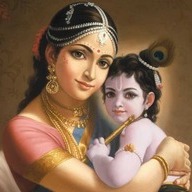A Yugachakra (also known as Chaturyuga, Maha Yuga, etc.) is a cyclical age (era) which encompasses the four yugas. Each cycle lasts for 4,320,000 years (12,000 divine years) and repeats the four yugas: Krita (Satya) Yuga, Tretayuga, Dvaparayuga and Kaliyuga.
As a Yugachakra progresses through four Yugas, the length of each Yuga and the general moral and physical condition of humanity within each Yuga is reduced by one-fourth. The Kaliyuga will last for 4,32,000 years. Near the end of Kali Yuga, when virtues are at their worst, a catastrophic and disastrous even takes place and a re-establishment of dharma occur to usher in the next cycle's Krita (Satya) Yuga, prophesied to occur by Kalki.
There are 71 Yugachakras in a Manvantara (the era of Manu) and 1,000 Yugachakras in a Kalpa (one day of Brahma).
When the times of all four yugas are combined, a divine era is formed. Kaliyuga is 4,32,000 years, Dwapara is 8,64,000 years, Treta is 12,96,000 years and Satyuga is 17,28,000 years. In this way there is a total Divya Yuga of 43,20,000 years. The magnitude of the time of the Gods is considered to be 360 times more than the magnitude of our time, hence Brahma has one day and an equally long night of one thousand divine yugas i.e. our 4,32,00,00,000 (four billion thirty-two crore) years. After 100 such years, Brahma along with his world becomes peaceful. In this way, being of duration, Brahma and Brahma's world also get destroyed after completion of duration. Even after the destruction of all these, Sachchidanandaghan Paramatma is not destroyed.
Let's talk about Manvantara or age of a Manu. Manu is the progenitor of humanity, and manvantara is an astronomical period of time measurement. Manvantara is a Sanskrit word, a compound of manu and antara, manu-antara or manvantara, literally meaning the duration of a Manu, or his life span. Each Manvantara is created and ruled by a specific Manu, who in turn is created by Brahma, the Creator himself. Manu creates the world, and all its species during that period of time, upon whose death, Brahma creates another Manu to continue the cycle of Creation, Vishnu on his part takes a new Avatar. On the other hand a new Indra and new Saptarishis are appointed.
Now, fourteen Manus and their respective Manvantaras constitute one Kalpa or a ‘Day of Brahma’, according to the Vedic Time Cycles. As discussed earlier, one Kalpa is equivalent to 1000 Yugachakras. At the end of each Kalpa, there is a period as long as a Kalpa of dissolution or Pralaya, wherein the most worlds are destroyed and the universe lies in a state of rest, which is called the, ‘Night of Brahma’. After the end of that night, Brahma starts his cycle of creation, throughout his life span which is 100 Brahma Varshas.
